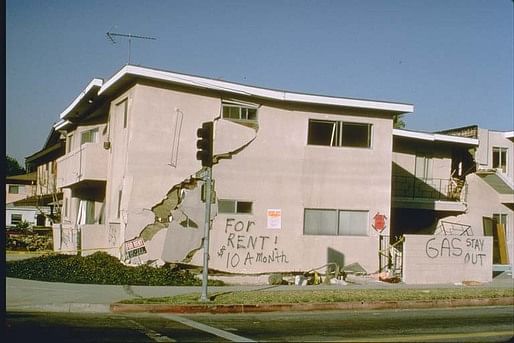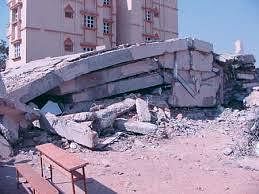
Hi Archinect,
I'm in a hospital basement auditorium in San Francisco for the first of six sessions to learn how to be part of the city's Neighborhood Emergency Response Team. It's a volunteer team, and the city offers the 20 hour training for free in order to help build the city's resilience in preparation for a major earthquake (or other disaster). Since it's not architecture school, those 20 hours are divided into six sessions.
If you read on, be advised that this not about architecture. It is about urban resilience!
6:40 pm: Our firefighter instructor says there are just over 300 firefighters in the city. In the case of an earthquake he won't be able to go home for at least 72h, and who will take care of his family? NERT, he says.
6:50 pm: We're signing forms. Release forms, etc. NERT members are generally protected by "Good Samaritan" laws, while we're doing things we've been trained to do. He's at pains to emphasize that it's not a "free rein"--you can't try to open up someone's blocked airway by inventing a new technique with a knife. If we get hurt while performing duties, we're covered for that.
7:00 pm: NERT has been around since 1989, after the last big earthquake. CERT, a partner program of Citizen Corps, developed by FEMA, is the equivalent and our training can transfer to certification in other parts of the U.S. We will receive safety equipment (helmet, gloves), a certificate, and ID. And we will be prepared, contributing to urban resilience!
7:02 pm: "Sometimes the most important role in a disaster is to comfort and reassure others."
7:05 pm: The curriculum for the six classes includes:
Class Session #1
Earthquake awareness,
Preparedness and Hazard
Mitigation
Class Session #2
Basic Disaster Skills
Fire Extinguishers/Behavior
Utilities Shut-offs
Hazardous Materials
Class Session #3
Disaster Medicine
Class Session #4
Light Search and Rescue
Class Session #5
Team Organization & Management
Disaster/Team Psychology
Terrorism
Class Session #6
Course Review
Skills hands-on Application
It's a ton of practical skills, including how to lift heavy people and things safely. That'll be good for me since I never stay in an apartment more than 12 months.
The two NERT Principles:
1. Make decisions and take actions that 'do the most good for the most people.'
2. NERTs don't get hurt.
Each neighborhood has its own NERT group that meets regularly for planning, and we will be able to join those. There's also a city-wide drill every year.
One Muni accident can occupy more than half of the emergency services in the city. There are 20,000 NERTs and they'll have a lot more capacity to help than a few hundred emergency workers.
Map of San Francisco--not much of the city is on bedrock. We're on the San Andreas fault.

Why is Van Ness street so wide? It's a fire break.
We're looking at pictures of building collapses--the below used to be a 3 storey building, and if you're not from the neighborhood you might not notice. A NERT should know that, being local.

Now we're watching footage of the Loma Prieta earthquake and the subsequent fires and rescue operations. It's pretty horrific, until it cuts to cheesy footage of the Oakland Raiders and San Francisco Giants World Series that resumed after a 10 day disruption. After the video, we discuss how we saw NERT and other civilians leading and taking part in rescue efforts.
What are the water sources in San Francisco? Cisterns--big underground pools of water. Fire trucks also pull water from the domestic water system--that was wiped out for the Marina in San Francisco when they were trying to fight fires there. There's also an auxiliary system just for fighting fires.
It takes 72 hours for outside resources to come in. Until then, any relief efforts are local.
If an earthquake happened right now, would you be prepared? Drop, cover, and hold on! Protect your head and neck. There isn't time to go to another place entirely--"don't go from a known to an unknown." People often look to see what others are doing before acting, but when an earthquake strikes, you have to act right away.
Two kinds of building collapse: cantilever and pancake.


If you're outside, you're supposed to go 1.5x the height of the building away, which is impossible most places in the city.
It's hard to say what the safest place will be when an earthquake hits. Maybe you have a nice mirror over your bed, our instructor jokes. Chuckles. Better than that would be to have a pair of shoes and a glow stick in a garbage bag tied to the base of your bag, so that you have footwear and a source of light.
7:50 pm: We're taking a break and trading in our paperwork for our student manuals. I buy two frozen pastas from a vending machine and combine them in one so people don't think see how much of a porker I am.
8:00 pm: Back from break. We're talking about basic preparedness. Wind up radios, an emergency plan (two exit routes from home and work, meeting place, hardcopy of key phone numbers), emergency kits: One gallon of water per person per day, for five days. Low sodium food helps you conserve drinking water. First aid kit. Flashlight. Lots and lots of stuff, but you still have to be able to carry it easily.
8:30 pm: Hazard mitigation: Many older homes are not bolted to their foundations, so make sure there are sill bolts. Then attach tall furniture to walls, and items such as vases and computer monitors can be attached to tables using museum putty, super velcro, or hardware. Everything attached! Store bleach and ammonia in different rooms.
9:00 pm: Escape routes, emergency food, how to line your toilet with a garbage bag when you don't have water to flush. Nitty gritty. Garbage bags, scissors, and duct tape. Garbage bags can create shelter or ponchos, or cover a broken window. Scissors can be used to make bandages out of clothing--always the victim's clothing, for hygiene and to preserve your own clothes.
If you're in San Francisco, there is a Loma Prieta 25th Anniversary Commemoration next week Friday, Oct 17, Noon–7:00 p.m, "a day of engaging emergency preparedness activities."
Thanks for reading!
Lian
P.S. It's almost worth it for the logo alone: 
P.P.S. I moved to San Francisco!
This blog was most active from 2009-2013. Writing about my experiences and life at Harvard GSD started out as a way for me to process my experiences as an M.Arch.I student, and evolved into a record of the intellectual and cultural life of the Cambridge architecture (and to a lesser extent, design/technology) community, through live-blogs. These days, I work as a data storyteller (and blogger at Littldata.com) in San Francisco, and still post here once in a while.



No Comments
Block this user
Are you sure you want to block this user and hide all related comments throughout the site?
Archinect
This is your first comment on Archinect. Your comment will be visible once approved.